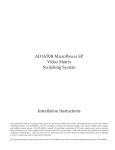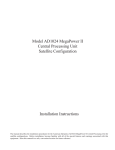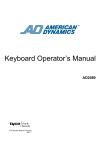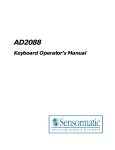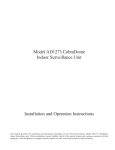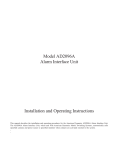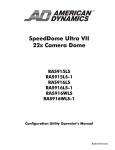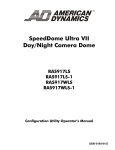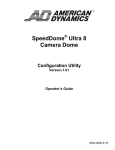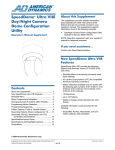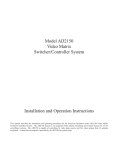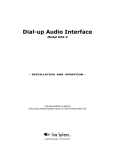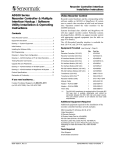Download American Dynamics AD1981 Specifications
Transcript
Artisan Technology Group is your source for quality new and certified-used/pre-owned equipment • FAST SHIPPING AND DELIVERY • TENS OF THOUSANDS OF IN-STOCK ITEMS • EQUIPMENT DEMOS • HUNDREDS OF MANUFACTURERS SUPPORTED • LEASING/MONTHLY RENTALS • ITAR CERTIFIED SECURE ASSET SOLUTIONS SERVICE CENTER REPAIRS Experienced engineers and technicians on staff at our full-service, in-house repair center WE BUY USED EQUIPMENT Sell your excess, underutilized, and idle used equipment We also offer credit for buy-backs and trade-ins www.artisantg.com/WeBuyEquipment InstraView REMOTE INSPECTION LOOKING FOR MORE INFORMATION? Visit us on the web at www.artisantg.com for more information on price quotations, drivers, technical specifications, manuals, and documentation SM Remotely inspect equipment before purchasing with our interactive website at www.instraview.com Contact us: (888) 88-SOURCE | [email protected] | www.artisantg.com AD2079 Keyboard Operator’s Manual Artisan Technology Group - Quality Instrumentation ... Guaranteed | (888) 88-SOURCE | www.artisantg.com Copyright 2000, Sensormatic Electronics Corporation Artisan Technology Group - Quality Instrumentation ... Guaranteed | (888) 88-SOURCE | www.artisantg.com AD2079 Keyboard Operator’s Manual Copyright 2000 All rights reserved. No part of this manual may be reproduced in any form without written permission from Sensormatic® Electronics Corporation. 8000-1810-01, Revision A Artisan Technology Group - Quality Instrumentation ... Guaranteed | (888) 88-SOURCE | www.artisantg.com WARNING Do not install this product in hazardous areas where highly combustible or explosive products are stored or used. To reduce the risk of fire or electric shock, do not expose appliance to rain or moisture. EQUIPMENT MODIFICATION CAUTION Equipment changes or modifications not expressly approved by Sensormatic Electronics Corporation, the party responsible for FCC compliance, could void the user's authority to operate the equipment and could create a hazardous condition. FCC COMPLIANCE This equipment has been tested and complies with the limits for a Class A digital device, according to Part 15 of the FCC Rules. These limits provide reasonable protection against harmful interference when the equipment operates in a commercial environment. This equipment generates, uses, and can radiate radio frequency energy, and, if not installed and used according to these instructions, may cause harmful interference to radio communications. Operation of this equipment in a residential area is likely to cause harmful interference. If this equipment is used in a residential area, users must correct the interference at their own expense. WARRANTY DISCLAIMER Sensormatic Electronics Corporation makes no representation or warranty of the contents of this manual and disclaims any implied warranties of merchantability or fitness. Sensormatic Electronics Corporation reserves the right to revise this manual and change its content without obligation to notify any person of these revisions. Copyright 2000 All rights reserved. No part of this manual may be reproduced in any form without written permission from Sensormatic® Electronics Corporation. Sensormatic and the Sensormatic logo are registered trademarks of Sensormatic Electronics Corporation. Product names mentioned herein may be trademarks or registered trademarks of other companies. PN- 8000-1810-01, Revision A Artisan Technology Group - Quality Instrumentation ... Guaranteed | (888) 88-SOURCE | www.artisantg.com Table of Contents CHAPTER 1: ABOUT THE AD2079 KEYBOARD CONTROLLER................................................................ 1-1 AD2079 FEATURES ................................................................................................................................................ 1-1 AD2079 KEYBOARD OVERVIEW ............................................................................................................................ 1-2 CHAPTER 2: CONNECTION AND SETUP OF THE AD2079.......................................................................... 2-1 SUPPLIED EQUIPMENT ............................................................................................................................................. 2-1 Connecting to a Switching System ..................................................................................................................... 2-1 Connections for Cable Distance of Seven Feet or Less.....................................................................................................2-1 Connections for Cable Distance of Greater than Seven Feet.............................................................................................2-2 Power Connections ...........................................................................................................................................................2-2 Installation Precautions.....................................................................................................................................................2-2 KEYBOARD SETUP .................................................................................................................................................. 2-4 Communications Protocols ................................................................................................................................ 2-4 Setting Keyboard Parameters ............................................................................................................................ 2-4 To Enter Setup Mode ........................................................................................................................................................2-4 To Change the Baud Rate .................................................................................................................................................2-4 To Set the Brightness Level ..............................................................................................................................................2-4 To Set the Speaker Volume...............................................................................................................................................2-5 To Set the Pan / Tilt / Zoom Motion Control Option........................................................................................................2-5 Resetting Keyboard Parameters ........................................................................................................................................2-5 BUILT-IN KEYBOARD OPERATIONS TEST ................................................................................................................ 2-7 Procedure to Initiate Built-In Test ....................................................................................................................................2-7 Speaker Test......................................................................................................................................................................2-8 LED Lamp Test.................................................................................................................................................................2-8 LED Brightness Test .........................................................................................................................................................2-8 Seven Segment LED Test .................................................................................................................................................2-8 Joystick Calibration / Speed Test ......................................................................................................................................2-8 Key Functionality Test....................................................................................................................................................2-10 Keyswitch Test................................................................................................................................................................2-10 Serial Communications Test ...........................................................................................................................................2-10 ROM Checksum Test......................................................................................................................................................2-11 CHAPTER 3: USING THE AD2079 IN OPERATE MODE ............................................................................... 3-1 User Numbers and Passcodes............................................................................................................................ 3-1 Logging On to the System.................................................................................................................................................3-1 Logging Off from the System............................................................................................................................................3-1 Selecting Monitors ............................................................................................................................................. 3-1 Calling a Camera to View on a Monitor............................................................................................................ 3-2 Controlling a Camera's Pan and Tilt................................................................................................................. 3-2 Locking and Unlocking a Camera ..................................................................................................................... 3-2 Controlling Camera Zoom ................................................................................................................................. 3-2 Controlling Camera Focus ................................................................................................................................ 3-2 Controlling the Camera Iris............................................................................................................................... 3-2 Controlling Camera Flip ................................................................................................................................... 3-3 Auto Focus / Auto Iris (SpeedDome Ultra Only) ............................................................................................... 3-3 Calling Presets (Shots)....................................................................................................................................... 3-3 Running System Tours........................................................................................................................................ 3-3 Holding a Tour................................................................................................................................................... 3-4 Re-Starting a Tour on Hold ............................................................................................................................... 3-4 Calling Salvos .................................................................................................................................................... 3-4 Auxiliary Control ............................................................................................................................................... 3-4 Acknowledging Alarms ...................................................................................................................................... 3-4 Table of Contents Artisan Technology Group - Quality Instrumentation ... Guaranteed | (888) 88-SOURCE | www.artisantg.com iii Viewing Satellite Sites........................................................................................................................................ 3-5 Running Patterns ............................................................................................................................................... 3-5 CHAPTER 4: PROGRAMMING WITH THE AD2079 ...................................................................................... 4-1 USING THE AD2079 IN PROGRAM MODE ................................................................................................................ 4-1 Setting Presets.................................................................................................................................................... 4-1 Setting Scratch-Pad Tours ................................................................................................................................. 4-1 Programming Patterns....................................................................................................................................... 4-1 Defining Patterns (for use with AD168 and CCM only) .................................................................................... 4-2 Clearing Patterns (for use with AD168 and CCM only).................................................................................... 4-2 Arming a Monitor .............................................................................................................................................. 4-2 Disarming a Monitor ......................................................................................................................................... 4-2 USING THE AD2079 IN MENU MODE ...................................................................................................................... 4-3 APPENDIX A: SPECIFICATIONS ...................................................................................................................... A-1 APPENDIX B: TROUBLESHOOTING ............................................................................................................... B-1 APPENDIX C: TYPICAL SYSTEM CONNECTIONS ...................................................................................... C-1 AD2079 TO AD2150/2350 (SEVEN FEET OR LESS) .................................................................................................C-1 AD2079 TO AD2150/2350 (GREATER THAN SEVEN FEET)......................................................................................C-2 AD2079 TO AD1996 CPU (SEVEN FEET OR LESS)..................................................................................................C-3 AD2079 TO AD1996 CPU (GREATER THAN SEVEN FEET) ......................................................................................C-4 AD2079 WITH AD1981 PORT EXPANDER ..............................................................................................................C-5 AD2079 TO AD168 CPU MODULE (SEVEN FEET OR LESS).....................................................................................C-6 AD2079 TO AD168 CPU MODULE (GREATER THAN SEVEN FEET) .........................................................................C-7 GLOSSARY............................................................................................................................................................. G-1 INDEX........................................................................................................................................................................I-1 DECLARATION OF CONFORMITY iv Table of Contents Artisan Technology Group - Quality Instrumentation ... Guaranteed | (888) 88-SOURCE | www.artisantg.com Chapter 1: About the AD2079 Keyboard Controller This chapter describes the features and setup of the AD2079 keyboard. It also describes the location and function of the keyboard's front panel components. AD2079 Features The AD2079 is a video control station that is compatible with several models of American Dynamics matrix switcher/controller systems. The AD2079 enables the user to view and control cameras at local and remote facilities, and to control auxiliary devices such as door locks and lights. Additionally, the operator can acknowledge alarms with the AD2079. Operators with key privileges can also perform programming functions with the AD2079. These functions include programming of presets (targets), patterns, and scratch-pad tours, as well as arming and disarming monitors for display of system alarms. Menu programming enables operators to set up the parameters of American Dynamics switching systems. A summary listing of AD2079 features follows: • user ID Entry - provides passcode logon/logoff capability • site ID - selects a site for satellite switching • monitor/camera selection - provides selection for viewing and control • pan/tilt and lens control - pan, tilt, and zoom control through joystick positioning. zoom, focus, and iris adjustments through lens control keys • joystick “Flip” push-button - enables user to flip cameras 180º from established position • tour functions - enables programming, running, and control of camera sequences • salvo functions - enables programming and simultaneous callup of multiple camera scenes • alarm functions - supports monitor alarm arming, disarming, and alarm acknowledgment • pattern and shot functions - enables programming and display of patterns and shots (presets) • selectable baud rate - 1200, 2400, 4800, 9600, 19,200, 38,400 bps (1200 default) • selectable LED brightness - enables eight different brightness levels • selectable speaker volume - enables eight different volume levels • Auto Focus/Auto Iris capability - supported when used with SpeedDome Ultra units • Camera Lockout – prevents other users from controlling a camera that the current user already has under control. About the AD2079 Keyboard Controller Artisan Technology Group - Quality Instrumentation ... Guaranteed | (888) 88-SOURCE | www.artisantg.com 1-1 A 4 B SITE 6 10 C 7 D 14 CAMERA MONITOR 15 Dk 16 17 AUXILARY ENTER OFF SHOT PATRN IRIS F1 USER F2 OFF SITE ARM LAST PROG NEXT LOCK RUN ACK 3 4 5 6 MONITOR SALVO CAMERA 0 MENU 3 Bk 8 11 13 CLOSE FOCUS Ck 9 9 8 18 OPEN NEAR 7 PROGRAM 1 1 2 HOLD OPERATE FAR 2 ZOOM WIDE CLEAR 12 21 TELE 19 22 20 AD2079 Keyboard Overview The AD2079 keyboard is comprised of the following elements: A. Site Display - shows the number of the site entered with the keypad when the SITE key (Ak) is pressed. 11. SALVO key - calls a specified salvo whose number is entered on the numeric keypad. B. Monitor Display - shows the number of the monitor entered with the keypad when the MONITOR key (Bk) is pressed. 12. CLEAR key - clears data entered on the numeric keypad C. Camera Display - shows the number of the camera entered with the keypad when the CAMERA key (Ck) is pressed. 13. RUN key - runs system and scratch-pad tours. D. Enter Display - shows the number entered on the NUMERIC KEYPAD (Dk). 14. ACK key - Acknowledges alarms, runs tours, sets and repeats patterns. 1. Keyswitch - enables the user to switch to the Operate, Program, or Menu modes of operation. When the keyswitch is set to Menu position, the secondary functions of the dual function keys are activated. DUAL FUNCTION KEYS 15. OFF/Page Left key - turns off auxiliary device in Operate mode. Displays page to left in Menu mode. 2. Joystick - enables the user to pan, tilt, zoom and flip the camera under keyboard control. 16. ON/Page Right key - turns on auxiliary device in Operate mode. Displays page to right in Menu mode. 3. PROG key - enables the user to set scratch-pad tours and patterns, as well as a number of other switching system functions. 17. CLOSE/Page Up key - closes camera iris in Operate mode. Displays prior page up in Menu mode. 4. ARM & OFF keys - enables the user to arm and disarm monitors for alarm display. 18. OPEN/Page Down key - Opens camera iris in Operate mode. Displays next menu page down in Menu mode. 5. USER key - used to log off a user from a system keyboard. 19. NEAR/Left Arrow key - Adjusts focus of near objects in Operate mode. Moves cursor left one character in Menu mode 6. F1 & F2 keys - special functions keys used to implement basic system commands and SpeedDome control 20. FAR/Right Arrow key - Adjusts focus of distant objects in Operate mode. Moves cursor right one character in Menu mode 7. LAST key - calls the prior camera displayed in a sequence (tour). 21. WIDE/Up Arrow key - Zooms out for wide angle view in Operate mode. Moves cursor up one character in Menu mode. 8. NEXT key - calls the next camera displayed in a sequence (tour). 22. TELE/Down Arrow key -Zooms in for telephoto view in Operate mode. Moves cursor down one character in Menu mode 9. HOLD key - Holds the current camera in a sequence (tour). 23. SHOT/Enter key - Calls presets in Operate mode. Sets presets in Program mode. Stores entered menu data. 10. LOCK key - a toggle key that locks or unlocks camera control for other keyboard operators. 24. PATRN/Exit key - runs and repeats patterns in Operate mode. Sets patterns in Program mode. Exits Menu mode. 1-2 24 CONTROL ON Ak 5 23 AD2079 Operator's Manual Artisan Technology Group - Quality Instrumentation ... Guaranteed | (888) 88-SOURCE | www.artisantg.com Chapter 2: Connection and Setup of the AD2079 This chapter describes the power and data connections between the AD2079 keyboard and the switching system being used. It also describes the setup of communications protocols and other keyboard parameters. Additionally, it describes built-in test procedures used to verify the operational integrity of the keyboard. Supplied Equipment The AD2079 is supplied with the following equipment: • Wall Transformer (specified for national and local electrical requirements) • One dual eight pin, wall-mount terminal block, with three jumper wires • One single eight pin, wall-mount terminal block • Two seven foot, eight conductor modular cables The transformer is connected from the wall to the terminal block. Power is then routed through the dual terminal block to the keyboard's eight pin RJ-45 port via the seven foot cable. Connecting to a Switching System The dual terminal block consists of two single eight-screw terminal blocks located on the left and right sides of the block interior (see illustration below). Each of the eight terminal screws in a connector set are routed to an RJ-45 connector at the bottom of the block. The J1 connector is connected to the AD2079 keyboard via one of the seven foot modular cables. The J2 connector is connected to the switching system via the other seven foot modular cable. Additional information showing typical system connections is included in Appendix C of this manual. Pin definitions for both the keyboard (J1) and system (J2) sides of the terminal block are listed in the table below: 4 5 5 3 4 6 6 3 7 2 7 8 1 8 2 1 Keyboard J1 System J2 Dual Terminal Block Screw Function 1 Transformer Power In (J1 only) 2 Shield 3 RS-422 T- 4 RS-232 RCD, RS-422 R+ 5 RS-232 XMIT, RS-422 T+ 6 RS-422 R- 7 Ground 8 Transformer Power In (J1 only) ! Power and Data Connections Only Not for Connection to Telephone Lines Dual Terminal Block Screw Designations Connections for Cable Distance of Seven Feet or Less For switching system connections where keyboard-to-system cable distance is seven feet or less, make the following connections using the jumpers included with the dual terminal block: J1 Pins J2 Pins 4 (rcd) ➜ 5 (xmit) 5 (xmit) ➜ 7 (ground) ➜ 4 (rcd) 7 (ground) Connection and Setup of the AD2079 Artisan Technology Group - Quality Instrumentation ... Guaranteed | (888) 88-SOURCE | www.artisantg.com 2-1 After connecting the jumpers, connect one of the seven foot modular cables from the J2 (system) jack of the dual terminal block, to the appropriate RS-232 port on the switching system. Connect the other seven foot modular cable from the J1(keyboard) jack of the dual terminal block, to the RJ-45 jack of the keyboard. Connections for Cable Distance of Greater than Seven Feet For switching system connections where keyboard-to-system cable distance is greater than seven feet, the following components are required: • Dual terminal block supplied with the AD2079 • A three-wire, shielded, 18 AWG cable supplied by the installer • Single terminal block supplied with the AD2079 Use the three-wire cable to connect the keyboard and switching system terminal blocks. The following table provides the connection points: Dual Block (J1 side) screws Single Block screws 4 (rcd)➜ 5 (xmit) 5 (xmit)➜ 4 (rcd) 7 (ground)➜ 7 (ground) Note: the cable shield connects to Pin 2 of the single terminal block After connecting the three-wire cable to the respective terminal blocks, connect one of the seven foot modular cables supplied with the AD2079 from the J1(keyboard) jack of the dual terminal block to the RJ-45 jack of the keyboard. Connect the other seven foot modular cable from the RJ45 jack of the single terminal block to the appropriate RS-232 port on the switching system. Power Connections Depending on national and local electrical requirements, the AD2079 is supplied with either a 120 VAC or a 230 VAC transformer. The 230 VAC transformer is supplied with a Euro-style IEC 320 type inlet. An appropriate detachable cord should be connected between the IEC 320 inlet and the power source. Connect the output leads from the wall transformer to screws 1 and 8 on the J1(keyboard) side of the dual terminal block. All power to the AD2079 is supplied from this connection. ! CAUTION! DO NOT INSERT THE WALL TRANSFORMER INTO THE POWER SOURCE UNTIL ALL CONNECTIONS HAVE BEEN VERIFIED Note: Typical system and test connections are illustrated in Appendix C of this manual. Installation Precautions The keyboard unit is susceptible to high electrostatic discharge potentials. Care should be taken to locate the unit so as to reduce the likelihood of accidental contact with ESD potentials, such as walking on a carpet under very dry conditions. Should accidental contact occur, and the keyboard unit experiences loss of camera control, momentarily remove power to the unit. This will re-establish communication with the connected unit or system, and reset the camera status. This installation should be made by qualified service personnel, and should conform to all local electrical codes. Safeguards must be taken to avoid unintentional operation by employees and maintenance personnel working about the premises, by falling objects, by customers, by building vibration, and by similar causes. 2-2 AD2079 Operator's Manual Artisan Technology Group - Quality Instrumentation ... Guaranteed | (888) 88-SOURCE | www.artisantg.com Keyboard Setup Setting up the AD2079 keyboard involves selection of the appropriate communications protocol, and setting the keyboard's baud rate, LED brightness, speaker volume, and PTZ motion control. Communications Protocols The AD2079 keyboard can operate with one of three communications protocols: • RS-232 (factory default setting) • RS-422 • RS-485 Select the appropriate protocol by setting an eight position DIP switch, labeled COMMUNICATIONS SWITCH, located on the bottom of the keyboard. The factory default setting is for RS-232 communications. To access the DIP switch, remove the bottom plate of the keyboard, and locate the switch next to the eight pin RJ-45 port. Unplug the wall transformer. Set the DIP switches according to the following table: Port Use RS-232 RS-422 RS-485 1 1 0 0 2 1 0 0 3 0 1 1 4 0 1 1 5 0 0 1 6 0 0 0 7 0 0 0 8 0 0 0 After completing the DIP switch settings, re-attach the keyboard’s bottom plate and plug in the transformer. 1 = 0N, 0 = OFF Setting Keyboard Parameters The operator can set the following four keyboard parameters: • Baud Rate – 1200 (default), 2400, 4800, 9600, 19,200, and 38,400 bps • LED Brightness - eight brightness levels • Speaker Volume - eight volume levels • Pan/Tilt/Zoom Motor Control – two control options can be set automatically or manually To Enter Setup Mode 1. Turn the three-position keyswitch to the MENU position. 2. Press the F1 key. "SETUP BAUD =" appears in the CAMERA display. The current value of the baud rate appears in the ENTER display. To Change the Baud Rate 1. Press the NEXT key to cycle through the available baud rate settings in the forward direction: 1200, 2400, 4800, 9600, 19,200, and 38,400. Press the LAST key to cycle through in the reverse direction. The factory default setting is 1200 baud. 2. When the appropriate baud rate appears in the display, press the PROG key to save the selection. You now have the option to either set the brightness level using the following procedure, or exit setup mode by pressing the F1 key. To Set the Brightness Level 1. After baud rate selection has been completed, the message "LEDS =" appears in the CAMERA display. The brightness level (an integer from 1 to 8) appears in the ENTER Connection and Setup of the AD2079 Artisan Technology Group - Quality Instrumentation ... Guaranteed | (888) 88-SOURCE | www.artisantg.com 2-3 display. The integer 1 signifies minimum brightness. The integer 8 signifies maximum brightness. 8 is the factory default setting. 2. To change the currently displayed brightness level, cycle through the levels using the NEXT or LAST keys to move in forward or reverse direction respectively. Each time the level changes, the intensity of the displayed characters changes as well. 3. When the appropriate integer appears in the ENTER display, press the PROG key to save the selection. You now have the option to either set the speaker volume level using the following procedure, or exit setup mode by pressing the F1 key. To Set the Speaker Volume 1. After LED brightness level selection has been completed, the message "SOUND" appears in the CAMERA display. The speaker volume level ("Off" or integer values from 1 to 7) appears in the ENTER display. "Off" indicates the speaker is disabled. The integer 1 signifies the minimum volume level. The integer 7 signifies the maximum volume level. 7 is the factory default setting. 2. To change the currently displayed volume level, cycle through the levels using the NEXT or LAST keys to move in forward or reverse direction respectively. Each time the level changes, a short tone sounds indicating the new level. 3. When the appropriate level appears in the ENTER display, press the PROG key to save the selection. You now have the option to either set the PTZ motion control option using the following procedure, or exit the setup mode by pressing the F1 key To Set the Pan / Tilt / Zoom Motion Control Option Depending on the particular switching system that is used with the AD2079 keyboard, the pan, tilt, and zoom (PTZ) motions of the system cameras are controlled by one of two methods: Repeat or Make/Break. Detailed descriptions of these two methods are beyond the scope of this manual, but a system administrator will be advised of the appropriate method to use, and will make the appropriate setting accordingly. 1. After speaker volume level selection has been completed, the letters "rpt =" appear in the CAMERA display. "AUTO" will appear in the ENTER display. “AUTO” indicates that the switching system being used will automatically select either the Repeat or Make/Break control method. 2. You can step through the “AUTO”, "OFF" and "ON" states by using the NEXT or LAST keys. If "OFF" is displayed, the Repeat method will be set off . If "ON" is displayed the Repeat method will be set on. The AD168 system operates with Repeat set to OFF. American Dynamics systems that operate with Repeat set to ON include AD1650B, AD2050, AD2052, AD2150, and AD2350. Consult with your system administrator about the appropriate setting for your system. 3. When the appropriate state appears in the ENTER display, press the PROG key to save the selection. You now have the option to either set the baud rate using the procedure indicated on page 2-3, or exit the setup mode by pressing the F1 key. Resetting Keyboard Parameters 2-4 1. To reset baud rate, LED brightness level, speaker volume level, and the PTZ motion control option to factory default settings, first unplug the keyboard's wall transformer. 2. Press and hold the F1 and PROG keys simultaneously while plugging the transformer back in. AD2079 Operator's Manual Artisan Technology Group - Quality Instrumentation ... Guaranteed | (888) 88-SOURCE | www.artisantg.com Built-in Keyboard Operations Test ! CAUTION ! The following procedures expose internal electrical components and should be performed by qualified service personnel only. The AD2079 has built-in test capability to verify the operational integrity of the unit's hardware and firmware. Built-in test functions include the following: • speaker test • LED lamp test • LED brightness test • LED seven segment test • joystick calibration / speed test • key functionality test • keyswitch test • serial communications test • ROM checksum test Procedure to Initiate Built-In Test 1. Unplug the keyboard's wall transformer. 2. Disconnect the matrix switching system's modular cable from the dual terminal block (J2). 3. Connect a jumper wire to pins 4 and 5 on the J1 side of the dual terminal block. 4. Detach the bottom plate of the keyboard by removing the four screws. 5. Press and hold down the button labeled "test switch", while simultaneously plugging in the wall transformer. XMIT/RCD SELF-TEST JUMPER CONNECTION 2079 KEYBOARD UNDERSIDE 5 4 5 3 TEST SWITCH 4 6 6 7 MODULAR CABLE DUAL TERMINAL BLOCK 3 2 7 1 8 8 2 TRANSFORMER 1 J1 J2 DO NOT CONNECT TO SYSTEM DURING BUILT-IN TEST Each of the tests is performed in sequence. Press the test switch button to advance to the next test procedure. To quit the test sequence, unplug and then re-plug the wall transformer. Connection and Setup of the AD2079 Artisan Technology Group - Quality Instrumentation ... Guaranteed | (888) 88-SOURCE | www.artisantg.com 2-5 Speaker Test The speaker test performs an audible check of the keyboard's speaker. A series of audio tones step through the frequency range of the speaker. During this test the CAMERA display shows the message "SOUND". The speaker test is repeated automatically, until the test switch button is pressed to advance to the LED lamp test. LED Lamp Test The LED lamp test simultaneously illuminates all segments of all LEDs in the four keyboard display sections. Press the test switch button to advance to the LED brightness test. LED Brightness Test In this test, all LEDs are stepped through the eight levels of intensity. The eight step sequence repeats continuously until the test switch button is pressed to advance to the seven segment LED test. Seven Segment LED Test This test simultaneously illuminates one of the seven segments for all 18 of the display LEDs for a brief interval. The next segment then illuminates, and then the next, and so on. The seven segment illumination cycle repeats continuously until the test switch button is pressed to advance to the joystick calibration / speed test. Joystick Calibration / Speed Test This test checks the joystick’s calibration, speed, and position. Codes representing these parameters appear in the keyboard’s ENTER, CAMERA, and MONITOR displays. When the joystick is in the center or “hands-free” position, dash marks appear in the ENTER display. The number “128” appears once in the MONITOR display, and twice in the CAMERA display. SITE MONITOR 1 2 8 CAMERA 1 2 8 1 2 8 ENTER The dashes in the ENTER display indicate that no pan or tilt commands are being transmitted. “128” in the MONITOR display indicates that the joystick is not being twisted in a clockwise or counter-clockwise direction. Twisting clockwise zooms in. Twisting counter-clockwise zooms out. The left-most “128” in the CAMERA display indicates the hands-free position for panning. The right-most “128” indicates the hands-free position for tilting. Note: due to variations in components and voltage sources, the center and endpoint numeric values for each keyboard may vary by small amounts. If the dashes are not displayed when the joystick is physically centered (when the operator releases the joystick), then the joystick is not properly calibrated. Contact American Dynamics Technical Support Center at 1-800-442-2225. 2-6 AD2079 Operator's Manual Artisan Technology Group - Quality Instrumentation ... Guaranteed | (888) 88-SOURCE | www.artisantg.com When the joystick is moved in any direction away from the center position, the dashes in the ENTER display are replaced by a four-digit movement code: pan speed (1-8) pan direction (left or right) tilt speed (1-8) tilt direction (up or down) Enter Display (Joystick in Motion) 8 L 1 d • From left to right, the first digit represents the pan speed. Speed is directly proportional to the distance from the joystick’s center position. “1” represents the slowest pan speed, and is therefore the position closest to the center. “8” represents the fastest pan speed, and is therefore the position furthest from the center. • The second digit (left to right) represents the panning direction (left or right, "L" or "r"). • The third digit (left to right) shows the tilt speed (up or down, "U" or "d"). Speed is directly proportional to the distance from the joystick’s center position. “1” represents the slowest tilt speed, and is therefore the position closest to the center. “8” represents the fastest tilt speed, and is therefore the position furthest from the center. • The fourth digit (left to right) shows the tilt direction (up or down, “U” or “d”) When the joystick is moved left or right, or forwards or backwards, the numbers on the CAMERA display change. Moving the joystick to the left or forwards increases the numeric values. Moving to the right or backwards decreases the numeric values. Zero is the lower limit for numeric values. “255” is the upper limit. CAMERA display: 1 2 8 1 2 8 When the joystick is twisted clockwise or counter-clockwise, the numbers on the MONITOR display change. Twisting clockwise performs the zoom-in or telephoto function. When twisting clockwise, an “I” (for zoom in) should appear before the digits, and the digits will increase. Twisting counter-clockwise performs the zoom-out or wide function. When twisting counterclockwise, a “O”(for zoom out) should appear before the digits, and the digits will decrease. Zero is the lower limit for numeric values. “255” is the upper limit. MONITOR display: Clockwise Motion I 2 0 2 O 1 0 2 MONITOR display: Counter-Clockwise Motion Connection and Setup of the AD2079 Artisan Technology Group - Quality Instrumentation ... Guaranteed | (888) 88-SOURCE | www.artisantg.com 2-7 Key Functionality Test This test performs a visual and audible check of keyboard key actions. When the test is started, each of the keyboard LED display sections shows a number representing the number of keys in that section of the keyboard. The numbers displayed are as follows: Display Section Number of Keys SITE 4 MONITOR 4 CAMERA 8 ENTER 22 Note: the count in the ENTER display includes the keys in the ENTER, DUAL FUNCTION, and CONTROL sections of the keyboard, as well as the “flip” button on the joystick. To verify proper operation, each key on the AD2079 keyboard must be pressed once. The keys can be pressed in any order. When a key is pressed, • An audible tone is sounded, verifying key recognition by the keyboard's microprocessor. • The number in the associated display decrements by one. Pressing the same key multiple times will not decrement the count by more than one (although the audible tones will continue). • When all keys have been pressed (including the joystick flip button), each display section will show a zero. Press the test switch button to advance to the keyswitch test. Keyswitch Test This test performs a visual check of the keyswitch positions. When the test is started, the ENTER display shows the current keyswitch position (OPER, PROG, or MENU) , and the SITE display shows the number 0, 1, or 2 corresponding to the respective keyswitch position. Rotate the keyswitch to all three positions, and verify that each of the three locations provides the appropriate message and number. Following verification of the keyswitch positions, press the test switch button to advance to the serial communications test. Serial Communications Test This test provides a communications check of the keyboard's RS-232/422/485 port. The test requires a loop back connection of the XMIT pin to the RCV pin on the keyboard output port, or on the dual terminal block (pin 4 connected to pin 5 on the J1 side only). During this test procedure the CAMERA display shows the message “SERIAL”. A sequence of test characters is sent from the microprocessor's transmit port to be verified at the processor's receive port. • If the test sequence is verified as correct, a double tone sounds on the speaker. • If the test sequence is not verified, or if the test connection is incorrect, a single tone sounds on the speaker. After completing the serial communications test, press the test switch button to advance to the ROM Checksum test. 2-8 AD2079 Operator's Manual Artisan Technology Group - Quality Instrumentation ... Guaranteed | (888) 88-SOURCE | www.artisantg.com ROM Checksum Test In this test a software checksum of the ROM contents is calculated for comparison with a known checksum value. The known value is printed on a label on the AD2079 microprocessor. The label is visible on the bottom of the unit, adjacent to the test switch button. When the test is run, the CAMERA display shows the checksum message CS =, and the ENTER display shows the four digit computed value of the checksum. Verify that the displayed checksum value matches the checksum printed on the label. When the ROM checksum test is completed, the built-in test sequence will return to the speaker test when the test switch button is pressed. To exit the built-in test mode, unplug the wall transformer, remove the test jumper from the dual terminal block, return the jumpers to their original positions, re-connect to the system, and then replug the transformer. Connection and Setup of the AD2079 Artisan Technology Group - Quality Instrumentation ... Guaranteed | (888) 88-SOURCE | www.artisantg.com 2-9 2-10 AD2079 Operator's Manual Artisan Technology Group - Quality Instrumentation ... Guaranteed | (888) 88-SOURCE | www.artisantg.com Chapter 3: Using the AD2079 in Operate Mode This chapter describes how to call cameras to view on workstation monitors. It also explains how to control the movement of pan/tilt cameras, and how to zoom, focus, and adjust the iris of a camera lens. In addition, it explains procedures for acknowledging alarms, and controlling auxiliary devices such as door locks and lights. User Numbers and Passcodes Depending on the setup of the switching system being used, an operator may have to enter a user code and passcode on the AD2079 keyboard in order to gain system access. If a user code is required, the letters “UC” appear in the CAMERA display to prompt the operator. After entering the appropriate user code, the operator is prompted by the letters “PSC” in the CAMERA display. After entering the appropriate passcode, the operator has system access. Consult with your system administrator to verify the appropriate user number and passcode for your keyboard. Logging On to the System To log on to the system: 1. Enter your user code (assigned by the system administrator) on the numeric keypad 2. Press the ACK key The system prompts for the user passcode by displaying "PSC" in the CAMERA display. 3. Enter the assigned passcode (maximum of six digits) on the numeric keypad. If an incorrect passcode is entered, press the CLEAR key, and then repeat step 3. 4. Press the ACK key. If the passcode is accepted, the CAMERA display window clears. This confirms that the keyboard is communicating with the system, and that a monitor can be "called" to the keyboard. Logging Off from the System When a user shift is completed, it is advisable to log off from the keyboard to insure system security. To log off from the system: 1. Press the USER key. “UC” appears in the CAMERA display (log off is complete). Selecting Monitors Workstation monitors display the video from the cameras and domes installed in local and/or satellite facilities. Each monitor has an identification number documented by the system administrator. To select a monitor: 1. Enter the monitor identification number on the numeric keypad (the number will appear in the ENTER display). 2. Press the MONITOR key. (the monitor identification number will appear in the MONITOR display window. The ENTER display will clear). This monitor has now been called to the keyboard. Camera video can now be viewed on the called monitor. Using the AD2079 in Operate Mode Artisan Technology Group - Quality Instrumentation ... Guaranteed | (888) 88-SOURCE | www.artisantg.com 3-1 Calling a Camera to View on a Monitor After a monitor has been called to the control of the AD2079 (see page 3-1), a camera can be called to view on the monitor. Each system camera has a unique identification number documented by the system administrator. To call a camera: 1. Enter the camera identification number on the numeric keypad (the number appears in the ENTER display). 2. Press the CAMERA key (the number clears from the ENTER display, and appears in the CAMERA display). The selected video input now appears on the monitor screen. After calling a camera to the selected monitor, any other camera can be called to the monitor by repeating the two step procedure described above. Controlling a Camera's Pan and Tilt Once an appropriately equipped camera has been called to view on a monitor, the operator can manually control the camera's movement. Pan is the side-to-side movement of the camera. Tilt is the up and down movement of the camera. The AD2079 joystick controls the panning and tilting of cameras connected to the switching system. As the joystick is moved to the left or right, and is moved towards or away from the operator, the camera will pan and/or tilt accordingly. For cameras with variable speed pan/tilt capability, camera movement speed is proportional to the positioning of the joystick. The further from the stationary center position the joystick travels, the faster the camera will move. There are eight independent speed levels for the up, down, left, and right directions. Center the joystick when the camera has been positioned appropriately. Locking and Unlocking a Camera After calling a pan/tilt camera to view and control on a system monitor, an operator can prevent other operators from controlling the movements of the called camera by pressing the LOCK key. To unlock the camera press the LOCK key again. Controlling Camera Zoom Zoom refers to the apparent action of moving closer to or farther away from an object, as seen through the camera lens. By pressing the TELE key, the camera appears to move closer to the object. By pressing the WIDE key, the camera appears to move away from the object. Zoom functions can also be controlled by twisting the control knob of the three-vector joystick. Twisting to the right enables the camera to zoom in. Twisting to the left enables the camera to zoom out. Controlling Camera Focus Focus refers to the action of adjusting the clarity of the camera image displayed on the monitor. To focus the camera on a distant object, press the FAR key. To focus on a closer object, press the NEAR key. To return to auto focus/auto iris capability when using the AD168 system equipped with a Control Code Module, press the OPEN and CLOSE keys simultaneously. See Appendix E for commands used with SpeedDome series domes used with the AD2083-02A code translator. Controlling the Camera Iris Normally, the brightness of a picture is controlled by the camera's auto gain and the auto/manual iris functions. However, there may be times when you would like the picture on the monitor to 3-2 AD2079 Operator's Manual Artisan Technology Group - Quality Instrumentation ... Guaranteed | (888) 88-SOURCE | www.artisantg.com appear darker or lighter. To brighten the picture, press the iris OPEN key. To darken the picture, press the iris CLOSE key. Controlling Camera Flip To “flip” the camera under keyboard control 180° from its current position (for uninterrupted surveillance of subjects who pass directly beneath the camera, press the button on the top of the joystick knob. The flip feature is active with the AD168 system. Note: on suitably equipped domes with the auto-flip function turned on, the dome can be flipped by holding the AD2079’s joystick in the down position. Auto Focus / Auto Iris (SpeedDome Ultra Only) SpeedDome Ultra dome units are designed with Auto Focus and Auto Iris capability. When the AD2079 keyboard is used to control SpeedDome Ultra units, focus and iris control can be performed manually by using the NEAR and FAR keys for focus control, and the OPEN and CLOSE keys for iris control. After performing manual control, the user can return to auto control mode by pressing the OPEN and CLOSE keys simultaneously. Calling Presets (Shots) A preset is a memorized location or scene that a pan/tilt camera can display on operator demand. Presets are also referred to as shots or targets. Depending on the matrix switching system used, the operator will have the option of calling a certain number of presets, each with its own unique identification number. Presets are positioned and stored in memory in the Program mode, which will be discussed in the next chapter. Once they are programmed, presets are called to view in the Operate mode. To call a preset: 1. After calling a pan/tilt camera to view (see page 3-2), enter the preset identification number on the numeric keypad (the preset number appears in the ENTER display). 2. Press the SHOT key to call the preset of the camera under control (the ENTER display clears). The selected video now appears on the monitor screen with appropriate pan, tilt, zoom, and focus adjustments. Running System Tours A tour is a dynamic sequence of camera views, each of which appears on a selected monitor screen for a specified dwell time, and each of which can have a pre-programmed preset status, auxiliary status, and connect next designation. System tours are also referred to as universal tours. System tours are programmed in the Menu mode, and are characterized by the particular switching system they are designed for. Additionally, there are monitor or "scratch-pad" tours, which are temporary tours programmed for the operator's currently selected monitor. Scratch-pad tours are set up in the Program mode, and will be discussed in the next chapter. To run a system (universal) tour: 1. Enter the appropriate monitor identification number on the numeric keypad (the monitor number will appear on the ENTER display). 2. Press the MONITOR key to gain control of the monitor. The monitor number will appear in the MONITOR display. The ENTER display will clear. 3. Enter the system tour number to be associated with the monitor under control. The tour number will appear in the ENTER display. Using the AD2079 in Operate Mode Artisan Technology Group - Quality Instrumentation ... Guaranteed | (888) 88-SOURCE | www.artisantg.com 3-3 4. Press the RUN key, and then press the ACK key within three seconds to run the designated system tour. Holding a Tour A tour can be stopped and held on a single camera entry by pressing the HOLD key. While a tour is on hold, all keyboard control actions (pan, tilt, lens adjustment, and auxiliary on/off functions) can be performed on the held camera. Re-Starting a Tour on Hold To re-start a held tour in the forward direction, Press the RUN key. To re-start a tour in the reverse direction, press the LAST key, followed by the RUN key. Note: tour direction can also be changed while a tour is in progress. To change the direction of a running tour, press the NEXT or LAST key, depending on which is appropriate in a given situation. Calling Salvos A salvo is the simultaneous display of multiple camera scenes on a group of numerically contiguous monitors. The number of allowable entries in a salvo is dependent on the particular switching system being used. Each system salvo has a unique identification number that defines the set of contiguous monitors. Salvos are programmed in the Menu mode or through system setup software, but are called to workstation monitors in the Operate mode. To call a salvo: 1. Enter the identification number of the first (lowest numbered) monitor of the contiguous monitor group on the numeric keypad. The monitor number will appear in the ENTER display. 2. Press the MONITOR key to gain control of the monitor. The monitor number will appear in the MONITOR display. The ENTER display will clear. 3. Enter the salvo identification number on the numeric keypad. The salvo number will appear in the ENTER display. 4. Press the SALVO key to call the salvo to the monitor group. The ENTER display will clear. Auxiliary Control An auxiliary is a relay that switches devices such as lights, door locks, and audible alarms. Such auxiliary relays are said to be momentary or latched. Either type can be controlled by the AD2079 keyboard using the auxiliary ON and auxiliary OFF keys. A momentary auxiliary remains active as long as its control key is pressed. An example of momentary auxiliary action is a door that remains unlocked as long the auxiliary ON key is pressed. When the key is released, the door returns to its locked state. A latched auxiliary remains active until it is deactivated using the appropriate off switch. An example of a latched auxiliary is a light. When the auxiliary ON key is pressed (and released), the light is turned on. When the auxiliary OFF key is pressed (and released), the light is turned off. Acknowledging Alarms When a monitor is armed for an alarm contact, the video input (camera view) associated with that alarm contact is displayed on the monitor when the alarm is activated. If the monitor is armed for manual clearance, any alarm displayed on the monitor can be acknowledged (cleared) by an AD2079 operator. To acknowledge (clear) an alarm: 1. 3-4 Call the monitor that is displaying alarm video. AD2079 Operator's Manual Artisan Technology Group - Quality Instrumentation ... Guaranteed | (888) 88-SOURCE | www.artisantg.com 2. Press the ACK key. If the monitor is sequencing multiple alarmed video inputs, hold or step to (using the next or last keys) the appropriate alarmed video input, and press the ACK key to clear the alarm. Continue to step to and ACK each alarm until all appropriate alarms have been cleared. Alarm signaling capability will vary depending on which switching system is connected to the AD2079. Consult your switching system manual to determine the particulars of the alarm interface. Viewing Satellite Sites A site is a complete matrix switcher / controller system, providing both local and remote control of resources in a satellite network. If your workstation supports satellite site switching capabilities, the SITE key accesses satellite sites. To gain access to a satellite site: 1. Enter the site number on the numeric keypad. The site number will appear in the ENTER display. 2. Press the SITE key. The site number will appear in the SITE display. The ENTER display will clear. 3. Call remote site monitors and cameras by the procedures discussed earlier in this chapter (see page 3-1). Running Patterns A pattern is a sequential series of pan, tilt, zoom, and focus commands defined for SpeedDome series domes. A pattern is programmed in real time, which means that the dome remembers each pattern segment in the actual time it takes the operator to execute a command. For example, if, during a pattern sequence, the dome focuses on a door for 30 seconds, the door scene will appear for 30 seconds when the pattern is called to run. Patterns are set in the Program mode, which is discussed in the following chapter. Patterns are run in the Operate mode. Note: pattern command sequences can vary depending on the switching system and accessories used. Consult the appropriate product manual(s) if necessary. To run a pattern: 1. Call the camera that the pattern will run on (see page 3-2). 2. Enter the pattern number on the numeric keypad. The pattern number will appear in the ENTER display. 3. Press the PATRN key (P-1, P-2, or P-3 appear in the ENTER display) and then press the RUN key. The camera will sequence through the pattern movements once. To repeat a pattern: 1. Follow the procedure described immediately above to run a pattern. 2. After pressing the PATRN key(P-1, P-2, or P-3 appear in the ENTER display), press the ACK key to repeat the pattern. To hold a pattern: 1. Follow the procedure to run a pattern. 2. After pressing the PATRN key, press the HOLD key to bring the camera or dome to the starting point of the pattern and hold there. Using the AD2079 in Operate Mode Artisan Technology Group - Quality Instrumentation ... Guaranteed | (888) 88-SOURCE | www.artisantg.com 3-5 3-6 AD2079 Operator's Manual Artisan Technology Group - Quality Instrumentation ... Guaranteed | (888) 88-SOURCE | www.artisantg.com Chapter 4: Programming with the AD2079 This chapter provides step-by-step instructions for keyboard operations performed with the keyswitch in the PROGRAM position. The chapter also includes a discussion of operations available with the keyswitch set in the MENU position. Using the AD2079 in Program Mode When operating with the keyswitch in the PROGRAM position, you can set presets, scratch-pad tours, and patterns. You can also arm and disarm monitors. Setting Presets To set a preset: 1. Call a monitor and camera to the keyboard (see Chapter 3). 2. Turn the three-position keyswitch to the PROGRAM position. 3. Using the joystick, move the camera to the appropriate position. Make the appropriate lens adjustments. 4. Enter the preset identification number on the numeric keypad (the number appears in the ENTER display). 5. Press the SHOT key (the ENTER display will clear). Setting Scratch-Pad Tours To set a scratch-pad tour: 1. Call a monitor to the keyboard (see Chapter 3). 2. Turn the three-position keyswitch to the PROGRAM position. 3. Enter "62" on the numeric keypad. Press the PROG key to clear any previously programmed scratch-pad tour. 4. Enter the first camera identification number of the tour (the number will appear in the ENTER display). 5. Press the CAMERA key (the ENTER display will clear). 6. Enter the appropriate dwell time number (1-60) on the numeric keypad (the number appears in the ENTER display). Press the PROG key (the ENTER display will clear). Repeat steps 3 through 6 until all the cameras in the tour have been programmed. 7. Press the RUN key to run the scratch-pad tour. Programming Patterns You can program up to three patterns per programmable dome. The length and complexity of a pattern are limited by two variables: • number of camera commands • time Each time you move the camera in any direction (with zoom, focus, or iris adjustments), you issue a command to the camera. The three patterns for a dome can collectively consist of up to 98 camera commands. Programming with the AD2079 Artisan Technology Group - Quality Instrumentation ... Guaranteed | (888) 88-SOURCE | www.artisantg.com 4-1 There is also a pattern time limit. A single pattern cannot have a duration longer than 400 seconds. How ever many commands have been issued, a pattern will stop recording once the time limit has elapsed. Note: pattern command sequences can vary depending on the switching system and accessories used. Consult the appropriate product manual(s) if necessary. The following pattern commands may not be compatible with your particular system requirements. Defining Patterns To define a pattern: 1. Turn the three-position keyswitch to the PROGRAM position. 2. Enter the pattern identification number on the numeric keypad (the number will appear in the ENTER display). 3. Press the PATRN key (the ENTER display will show “P-1”, “P-2”, or “P-3”). 4. Press the PROG key. Using the joystick and lens keys, maneuver the called camera to define the pattern. 5. Press the ACK key to save the pattern (the ENTER display will clear). Clearing Patterns To clear a pattern: 1. Turn the three-position keyswitch to the PROGRAM position. 2. Enter the identification number of a previously defined pattern on the numeric keypad (the number will appear on the ENTER display). 3. Press the PATRN key (the ENTER display will show “P-1”, “P-2”, or “P-3”). 4. Press the CLEAR key to remove the pattern (the ENTER display will clear). Arming a Monitor When a monitor is armed, the camera video associated with an alarm for that monitor appears when an alarm has been triggered. To arm a monitor, do the following: 1. Call the monitor to be armed (see Chapter 3). 2. Turn the three-position keyswitch to the PROGRAM position. 3. Enter the arming type identification number on the numeric keypad (the number will appear in the ENTER display). Note: for information about arming types, consult the operating manual for the switching system being used. 4. Press the ARM key. The ENTER key will clear, and the selected monitor screen displays the arming type code for five seconds. Disarming a Monitor When a monitor is disarmed, the camera video from alarms is not displayed when an alarm has been triggered. To disarm a monitor, do the following: 4-2 1. Call the monitor to be disarmed (see Chapter 3). 2. Turn the three-position keyswitch to the PROGRAM position. 3. Press the OFF key to disarm the called monitor. AD2079 Operator's Manual Artisan Technology Group - Quality Instrumentation ... Guaranteed | (888) 88-SOURCE | www.artisantg.com Using the AD2079 in Menu Mode When the three-position keyswitch is in the MENU position, you are able to view the main menu of the switching system being used. With the keyboard in MENU mode, the appropriate functions on the dual function keys activate (see illustration in Chapter 1): • Page Left (Off)- displays the menu page to the left • Page Right (On) - displays the menu page to the right • Page Up (Close) - displays prior menu page up • Page Down (Open) - displays next menu page down • Left Arrow (Near) - moves cursor left one character • Right Arrow (Far) - moves cursor right one character • Up Arrow (Wide) - moves cursor up one character • Down Arrow (Tele) - moves cursor down one character • Enter (Shot) - stores entered menu data • Exit (Patrn) - exits the current screen and returns to the previously displayed screen Several American Dynamics switching systems provide menu programming for a variety of functions. Camera groups, system tours, system salvos, alarm contact tables, monitor arming, and event timers are among the variables that may be defined through menu programming. For information about the specific tasks that you can do from the main menu, refer to the appropriate switching system operating instructions. Programming with the AD2079 Artisan Technology Group - Quality Instrumentation ... Guaranteed | (888) 88-SOURCE | www.artisantg.com 4-3 4-4 AD2079 Operator's Manual Artisan Technology Group - Quality Instrumentation ... Guaranteed | (888) 88-SOURCE | www.artisantg.com Appendix A: Specifications References: RS-485 RS-422 EIA 485 EIA 422-A CCITT V. 11 EIA 232-D CCITT V. 24 RS-232 Keyboard Specifications: Input: AD2079: AD2079-1: Power Connection: Size: Weight: Paint Color: Display Lens: Display Diodes: Joystick: Keys: 9 VAC, 50/60 Hz, 5 W 8 VAC, 50/60 Hz, 600 mA Wall Transformer 5.25” W x 16.5" L x 1. 6" H 5.5 lb. (2.55 Kg) Black Full length smoked glass with beveled edge 7 segment green LEDs 3 vector, variable speed with momentary pushbutton Momentary pushbutton Communications: RS-485 RS-422 RS-232 Surge protected Surge protected Selectable Baud Rate (1200, 2400, 4800, 9600, 19,200, 38,400) surge protected Central Processor: Processor: Motorola MC68HC711-E9 Package: 52 Pin PLCC package Environmental: Operating Temp: Humidity: Storage Temp: 0° to +50°C (32° to 122°F) 5 to 95% non-condensing -40°C to 70°C (-40° to 155°F) AD2079 Specifications Artisan Technology Group - Quality Instrumentation ... Guaranteed | (888) 88-SOURCE | www.artisantg.com A-1 A-2 AD2079 Operator's Manual Artisan Technology Group - Quality Instrumentation ... Guaranteed | (888) 88-SOURCE | www.artisantg.com Appendix B: Troubleshooting Problem Check List ✘ No power to keyboard ! Check AC outlet ! Check wall transformer connections ! Check modular cable connections to keyboard and terminal block. ! Measure transformer output at terminal block. ✘ No response to keystrokes (power verified) ! Check connection of terminal block to system controller's communication port. ! Check baud rates for keyboard and system controller. ! Check DIP switch setting for communications protocol. ! Run built-in test to verify keyboard operation. ✘ Keyboard responds to keystrokes on some, but not all keys. ! Verify keyswitch position. With the keyswitch in the OPERATE position, the OFF, ARM, and PROG keys are disabled. ! Run built-in test to verify keyboard operation. ✘ Cannot perform menu positioning with dual function section keys ✘ Display LEDs not visible. ! Verify keyswitch position. Switch must be in MENU position to perform menu programming functions. ! Verify LEDs brightness level. ! Run built-in test to verify LED operation. ! Re-initialize firmware ✗ Keyboard speaker not audible. ! Verify speaker volume level. ! Check that switching system controller has not disabled speaker. ! Run built-in test to verify speaker operation. ✘ Cannot set up baud rate, brightness level, or speaker volume. ! Verify that keyswitch is in MENU position. ✘ Cannot access main menus of system CPU. ! Verify that keyswitch is in MENU position. ! Verify that correct monitor is selected for menu programming. ! Verify CPU program monitor output is connected ✘ Pan/tilt cameras move continuously and/or cursor scrolls continuously in MENU mode. ! Run built-in test to verify joystick operation. AD2079 Troubleshooting Artisan Technology Group - Quality Instrumentation ... Guaranteed | (888) 88-SOURCE | www.artisantg.com B-1 B-2 AD2079 Operator's Manual Artisan Technology Group - Quality Instrumentation ... Guaranteed | (888) 88-SOURCE | www.artisantg.com TYPICAL SYSTEM CONNECTIONS AD2079 to AD2150/2350 Connection shown where distances between keyboard and AD2150/2350 are less than seven feet AD2079 Jumper wires RCD Modular Cable XMIT 5 4 5 3 6 3 6 GND 7 DUAL TERMINAL BLOCK 4 2 7 1 8 8 Wall Transformer 2 1 J1 J2 Keyboard System Modular Cable ALARMS RLY CODE CAMERAS 1 2 3 4 5 6 7 8 9 10 11 12 13 14 15 16 17 18 19 20 21 22 23 24 25 26 27 28 29 30 MONITORS 31 32 1 2 1 3 2 4 120V 60Hz 5 3 KEYBOARDS 2 3 4 5 RS232 PORTS AD2150/2350 C-1 Artisan Technology Group - Quality Instrumentation ... Guaranteed | (888) 88-SOURCE | www.artisantg.com TYPICAL SYSTEM CONNECTIONS AD2079 TO AD2150/2350 Connection shown where distances between keyboard and AD2150/2350 are over seven feet 3-wire, shielded Belden 8770, or equivalent AD2079 Modular Cable 5 4 RCD XMIT 3 4 6 Wall Transformer 2 7 GND 1 8 J1 5 3 6 2 7 1 8 J2 SINGLE TERMINAL BLOCK DUAL TERMINAL BLOCK Modular Cable ALARMS RLY CODE CAMERAS 1 2 3 4 5 6 7 8 9 10 11 12 13 14 15 16 17 18 19 20 21 22 23 24 25 26 27 28 29 30 MONITORS 31 32 1 2 1 3 2 4 120V 60Hz 5 3 KEYBOARDS 2 3 4 5 RS232 PORTS AD2150/2350 C-2 Artisan Technology Group - Quality Instrumentation ... Guaranteed | (888) 88-SOURCE | www.artisantg.com TYPICAL SYSTEM CONNECTIONS AD2079 to AD1996 CPU Connection shown where distances between keyboard and AD1996 controller are less than seven feet AD2079 Jumper wires RCD Modular Cable XMIT 5 4 5 3 6 3 6 GND 7 DUAL TERMINAL BLOCK 4 2 7 1 8 8 Wall Transformer 2 1 J1 J2 Keyboard System Modular Cable DATA LINE PORTS PROG MON 120V 60HZ 1 2 1 2 3 4 5 6 7 8 9 10 AD1996 C-3 Artisan Technology Group - Quality Instrumentation ... Guaranteed | (888) 88-SOURCE | www.artisantg.com TYPICAL SYSTEM CONNECTIONS AD2079 TO AD1996 CPU Connection shown where distances between keyboard and AD1996 are over seven feet 3-wire, shielded Belden 8770, or equivalent AD2079 JJ0007 Cable * 5 XMIT 4 RCD 3 4 6 Wall Transformer * 2 7 GND 1 8 J1 5 3 6 2 7 1 8 J2 HP0047 TERMINAL BLOCK ** HP0082 TERMINAL BLOCK * JJ0007 Cable ** DATA LINE PORTS PROG MON 120V 60HZ 1 2 1 2 3 4 5 6 7 8 9 10 AD1996 * Items supplied with AD2079 keyboard **Items supplied with AD1996 system C-4 Artisan Technology Group - Quality Instrumentation ... Guaranteed | (888) 88-SOURCE | www.artisantg.com TYPICAL SYSTEM CONNECTIONS AD2079 with AD1981 Port Expander AD2079 AD2079 Modular Cable Modular Cable Dual Terminal Block 5 4 6 7 3 2 Dual Terminal Block 5 4 3 6 2 7 1 1 8 8 J1 J2 J1 J2 3-wire, shielded Belden 8770, or equivalent 1 2 6 To CPU 3 7 4 8 KBD d 5 1 9 2 6 KBD c KBD b 3 7 4 8 5 9 KBD a AD1981 1 2 6 3 7 4 8 3-wire, shielded Belden 8770, or equivalent 5 3 9 4 5 2 1 6 7 8 Single Terminal Block Modular Cable DATA LINE PORTS PROG MON 120V 60HZ 1 2 1 2 3 4 5 6 7 8 9 10 AD1996 NOTE: AD1996 shown for illustration. Any controller with RS-232 ports can be controlled from AD2079 via AD1981 Port Expander C-5 Artisan Technology Group - Quality Instrumentation ... Guaranteed | (888) 88-SOURCE | www.artisantg.com D E R c d m n o G F F S G Q H E I P ! " # $ % & $ ' # E F O K P L F E O M F T M U L V G W N P G N O G J X G K I K P F K H I L G P K Q F G K I G M Y G G F G F Z G G p 5 B J N " 6 7 ( % 8 9 % ( : A C ( ; < = > ) * + , - 2 . , / 3 & 0 1 + , 4 [ - ? @ $ # # % $ \ : ] % 6 A 4 ( ^ ' $ % ! _ ^ : ! \ a ` ( \ " 6 # $ % ( ` & 9 $ \ ' ` # ( + ) & b * ! " # ( a c d e f g h i c h j C-6 Artisan Technology Group - Quality Instrumentation ... Guaranteed | (888) 88-SOURCE | www.artisantg.com c k i l ( % I S T a V U b U ` V T W _ X ] Y ^ T U _ Z U [ ^ T \ c U 4 d \ H 5 6 [ 7 e V / f ] 1 _ 8 : * + , - . / . 0 - m # n ( Y T 1 7 - / Z + V 1 ? _ - - 1 ` V + V U 1 ; Z g 1 . @ V V 7 W Z + U ] , X g 1 ^ V * l V ] 9 h X ; \ V < V V = V U = X > 8 A o 1 B C Q J K L P R M 4 i . - - D / . ; 9 j * / k 1 / $ % & ' E = N F O P # ( < " G H G ) I 2 3 ! ! * + , - . / . 0 - 1 F * ; ; 1 A p * 7 ; A * 2 < D p ' l m " ) r s l r t l u s C-7 Artisan Technology Group - Quality Instrumentation ... Guaranteed | (888) 88-SOURCE | www.artisantg.com v q 3 * + , - 1 C-8 AD2079 Operator's Manual Artisan Technology Group - Quality Instrumentation ... Guaranteed | (888) 88-SOURCE | www.artisantg.com Glossary A alarm The system's response when a camera input changes from its normal state to its abnormal state (if the system has been configured to respond to such a condition).When an alarm is triggered, the TOUCH TRACKER beeps until you acknowledge the alarm via the Ack button. arming Arming is the process by which a video monitor or monitor block is associated with a specific alarm contact, and is assigned an appropriate monitor arming code. arming code A monitor’s arming code defines how an alarm scene will be displayed, queued, and cleared on the monitor. Display methods include Single, Dual, and Block. Queuing methods include Hold and Sequence. Clearance methods include Instant, Auto, and Manual. auxiliary A relay switch which controls the “on” or “off” state of devices such as door locks, gates, and lights. B baud rate A rate of transmission measured by the number of bits per second sent over a computer-controlled communications line. C cable two or more wires bundled together. called monitor The monitor that displays the video that is being controlled by the AD2079. camera command A directive issued to the camera via the AD2079 - a pan, tilt, zoom, focus, or iris command. camera lock camera lock is a programmable function which prevents a user or keyboard from controlling camera pan/tilt and lens adjustments, preset positioning, and auxiliary actions. checksum A summation of digits or bits used primarily for checking purposes and summed according to an arbitrary set of rules. The checksum is used to verify the integrity of data. D dwell time The amount of time an individual camera scene is displayed on a monitor screen before being replaced by the next scene in sequence. F fixed camera A camera which views a scene from a single perspective. A fixed camera cannot pan or tilt, or make automatic lens adjustments. flip To instantaneously position a dome 180° in the opposite direction of where it is currently pointing. focus The process of adjusting the clarity of a scene or an object, as seen through a camera. AD2079 Glossary Artisan Technology Group - Quality Instrumentation ... Guaranteed | (888) 88-SOURCE | www.artisantg.com G-1 I input A device such as a smoke detector or twilight sensor that, when configured to do so, can trigger an alarm when it undergoes a change in state. iris The camera component that determines how light enters the camera. By adjusting the iris, you can adjust the brightness and darkness of the video on the monitor. J joystick The AD2079 keyboard's three-vector control device that enables the user to control the movement (pan, tilt, and zoom) of a pan/tilt camera or dome. K keypad The portion of the AD2079 containing the buttons that enable you to call up an individual camera, control a camera's iris, display shots, run Monitor Tours, and arm or disarm monitors. L LED Light emitting diode. The display section of the AD2079 contains 18 seven segment LEDs which display site, monitor, and camera numbers, as well as the various status messages described in this manual. latched relay An auxiliary relay that remains active until it is deactivated using the appropriate off switch. An example of a latched auxiliary is a light. When the keyboard controller’s Auxiliary On button is pressed, the light is turned on. When the Auxiliary Off button is pressed, the light is turned off. See also auxiliary and momentary relay. log in If this function is enabled, system keyboard access is restricted to only those users entering a user number (1-64) and a six digit passcode. When the function is disabled, system access is restricted only by the priority level set for the keyboard in use. M momentary relay An auxiliary relay that is active as long as its control button is pressed. An example of momentary auxiliary action is a door that remains unlocked as long as the Auxiliary On button is pressed. When the button is released, the door returns to its locked state. See also auxiliary and latched relay. monitor The screen where camera video is displayed. monitor tour A sequence of video inputs with specified dwell times that are displayed one after the other on a monitor called manually by a system operator. See also system tour O output An auxiliary signal. Outputs lock and unlock doors, turn lights on and off, activate audible alarms, etc. Outputs can also be initiated automatically in response to an alarm. P pan Side to side camera movement pattern A sequence of pan, tilt, zoom, focus, and iris movements from a single programmable dome. The dome “learns” these movements in real time through keyboard programming, and can replay them automatically. G-2 AD2079 Operator’s Manual Artisan Technology Group - Quality Instrumentation ... Guaranteed | (888) 88-SOURCE | www.artisantg.com preset A preset is a pre-positioned camera scene which can be programmed with cameras installed with pan/tilt and motorized lens capability. A preset can be called to a monitor through manual keyboard control, or can appear automatically as part of a system tour or salvo. Presets are also referred to as Targets or Shots. protocol The method by which data is transmitted. Essentially, the language a system speaks. RS-232, RS-422, and RS-485 are protocols that can be used by the AD2079. S salvo A salvo is a simultaneous display of multiple camera scenes appearing on a contiguous set of monitors. A salvo can be called manually by a system operator, or can appear automatically as part of a system tour or alarm call-up. switching system A system in which an incoming video signal or signals are routed to a bay, and then can be switched either manually or automatically to any one of multiple video outputs. The AD168 switching system can accommodate up to 168 video inputs and up to 24 video outputs. system tour Also referred to as a universal tour. A programmed sequence of cameras with assigned dwell times, presets, auxiliaries, and connect next designations. T tilt Up and down camera movement. tour A tour is a sequence of camera scenes viewed on at a time on a video monitor. A monitor tour is a temporary sequence of scenes programmed for a single monitor. A monitor tour can contain up to 64 camera, with a dwell time for each camera. A system tour is a pre-programmed through S³ setup software. 64 system tours can be programmed for callup, either by an operator, or an automatic timed event, to any system monitor at any time. Each system tour can contain up to 64 entries with dwell time, with optional preset and auxiliary action for each camera. Z zoom The action of apparently moving closer to or away from an object, as viewed through a camera lens. AD2079 Glossary Artisan Technology Group - Quality Instrumentation ... Guaranteed | (888) 88-SOURCE | www.artisantg.com G-3 G-4 AD2079 Operator’s Manual Artisan Technology Group - Quality Instrumentation ... Guaranteed | (888) 88-SOURCE | www.artisantg.com Index A F accessory equipment ∙ 2-1 alarm definition ∙ G-1 alarms acknowledging ∙ 3-4 disarming a monitor ∙ 4-2 monitor arming ∙ 4-2 arming definition ∙ G-1 arming a monitor ∙ 4-2 arming code definition ∙ G-1 auxiliary definition ∙ G-1 auxiliary control ∙ 3-4 features, AD2079 ∙ 1-1 flip definition ∙ G-1 focus definition ∙ G-1 focus control ∙ 3-2 I iris definition ∙ G-2 iris control ∙ 3-2 J B joystick calibration/speed test ∙ 2-6 baud rate ∙ 2-3 definition ∙ G-1 brightness level ∙ 2-3 built-in test ∙ 2-5 C cable connections, greater than seven feet ∙ 2-2 cable connections, seven feet or less ∙ 2-1 calling a camera ∙ 3-2 calling a salvo ∙ 3-4 calling presets ∙ 3-3 camera lock ∙ 3-2 definition ∙ G-1 communications DIP switch ∙ 2-3 communications protocols ∙ 2-3 connections, AC power ∙ 2-2 connections, keyboard to system ∙ 2-1 D disarming a monitor ∙ 4-2 display descriptions, LEDs ∙ 1-2 dome commands ∙ E-1 dual function keys ∙ 4-3 E K key descriptions ∙ 1-2 key functionality test ∙ 2-8 keyboard layout ∙ 1-2 keyboard parameters baud rate ∙ 2-3 LED brightness ∙ 2-3 resetting ∙ 2-4 speaker volume ∙ 2-3 keyswitch test ∙ 2-8 L latched auxiliary definition ∙ G-2 LED definition ∙ G-2 LED brightness test ∙ 2-6 LED display descriptions ∙ 1-2 LED lamp test ∙ 2-6 license agreement, software ∙ D-1 locking a camera ∙ 3-2 log in definition ∙ G-2 log off ∙ 3-1 log on ∙ 3-1 equipment supplied ∙ 2-1 I-1 Index Artisan Technology Group - Quality Instrumentation ... Guaranteed | (888) 88-SOURCE | www.artisantg.com M momentary relay definition ∙ G-2 monitor definition ∙ G-2 monitor selection ∙ 3-1 monitor tour definition ∙ G-2 O operate mode ∙ 3-1 P pan definition ∙ G-2 pan/tilt control ∙ 3-2 passcode default ∙ 3-1 user ∙ 3-1 pattern definition ∙ G-2 patterns clearing ∙ 4-2 running ∙ 3-5 power connections ∙ 2-2 presets ∙ 3-3 definition ∙ G-3 programming menu mode ∙ 4-3 program mode ∙ 4-1 definition ∙ G-3 satellite sites ∙ 3-5 scratch-pad tours ∙ 4-1 serial communications test ∙ 2-8 setting presets ∙ 4-1 setup mode ∙ 2-3 seven segment LED test ∙ 2-6 software license agreement ∙ D-1 speaker test ∙ 2-6 speaker volume ∙ 2-4 specifications ∙ A-1 switch settings, RS-232 ∙ 2-3 switch settings, RS-422 ∙ 2-3 switch settings, RS-485 ∙ 2-3 switching system definition ∙ G-3 system tour definition ∙ G-3 system tours ∙ 3-3 T tilt definition ∙ G-3 tour definition ∙ G-3 tours holding ∙ 3-4 re-starting ∙ 3-4 troubleshooting ∙ B-1 U user passcodes ∙ 3-1 R Z ROM checksum test ∙ 2-9 zoom definition ∙ G-3 zoom control ∙ 3-2 S salvos ∙ 3-4 I-2 AD2079 Operator's Manual Artisan Technology Group - Quality Instrumentation ... Guaranteed | (888) 88-SOURCE | www.artisantg.com DECLARATION OF CONFORMITY According to ISO/IEC Guide 22 and EN45014 Manufacturer’s Name: Sensormatic Electronics Corporation Manufacturer’s Address: 1 Blue Hill Plaza 2nd Floor Pearl River, New York, 10965 USA Declares, that the product(s) listed below: Name/Type: System Keyboard (keyboard provided with external power supply) Model Number: AD2079-1 AD2079R-1 complies with all applicable directives as demonstrated by conformance to the following Product Specifications: Safety: EN 60950: 1992 EMC: EN 50130-4: 1995 EN 55022: 1994 , Class B EN 61000-3-2: 1995 EN 61000-3-3: 1995 EN 61000-4-2: 1995 EN 61000-4-3: 1996 EN 61000-4-4: 1995 EN 61000-4-5: 1995 EN 61000-4-6: 1996 EN 61000-4-11: 1994 Supplementary Information: The products herewith comply with the requirements of the Low Voltage Directive, 73/23/EEC as amended by 93/68/EEC, and the EMC Directive, 89/339/EEC as amended by 93/68/EEC. Pearl River, NY, USA 1 October, 2000 Harold D. Johnson, Ph.D. Director of Engineering European Contact: Sensormatic France S.A. 7, rue Alexis de Tocqueville, Parc de Haute Technologie, 92183 ANTONY CEDEX Artisan Technology Group - Quality Instrumentation ... Guaranteed | (888) 88-SOURCE | www.artisantg.com Sensormatic Video Systems Division One Blue Hill Plaza Pearl River, New York, 10965 Technical Support Center 1-800-442-2225 Business (845) 624-7600 PN: 8000-1810-01, Rev. A 2 Artisan Technology Group - Quality Instrumentation ... Guaranteed | (888) 88-SOURCE | www.artisantg.com Artisan Technology Group is your source for quality new and certified-used/pre-owned equipment • FAST SHIPPING AND DELIVERY • TENS OF THOUSANDS OF IN-STOCK ITEMS • EQUIPMENT DEMOS • HUNDREDS OF MANUFACTURERS SUPPORTED • LEASING/MONTHLY RENTALS • ITAR CERTIFIED SECURE ASSET SOLUTIONS SERVICE CENTER REPAIRS Experienced engineers and technicians on staff at our full-service, in-house repair center WE BUY USED EQUIPMENT Sell your excess, underutilized, and idle used equipment We also offer credit for buy-backs and trade-ins www.artisantg.com/WeBuyEquipment InstraView REMOTE INSPECTION LOOKING FOR MORE INFORMATION? Visit us on the web at www.artisantg.com for more information on price quotations, drivers, technical specifications, manuals, and documentation SM Remotely inspect equipment before purchasing with our interactive website at www.instraview.com Contact us: (888) 88-SOURCE | [email protected] | www.artisantg.com


















































